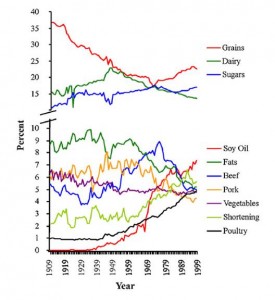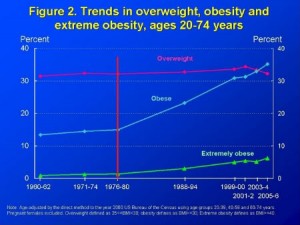Many people don't know this, but before 1979, there were no public health guidelines for what foods our citizens should eat. So where would we be now without a food pyramid?
In the 1950s, a researcher named Ancel Keys developed a theory that certain dietary fats were a major cause of heart disease. Although the support for this theory was weak, it would eventually become the basis of nutritional recommendations for the entire country. This eventually morphed in to the theory that dietary cholesterol and saturated fat cause heart disease, and for the public it was easy to make the jump that these also cause weight gain and obesity.
So the US government decided to step in for the benefit of the uneducated masses and save us from imminent death and obesity.
The result? Since 1979, when the McGovern Committee made the first "Dietary Guidelines for Americans," we've been encouraged to eat less animal fat, less cholesterol, and more grains. And, we were pretty successful at it; Americans adopted our new food guidelines and embraced a low-fat way of eating for the last 30 years. Here's a chart of how are diets have changed over the last 100 years:

Who can tell me when it the obesity rate really starts to rise? Oh wow, 1980...but that's when we got all the good advice to eat less animal fat, more grains, and more vegetable oil.
So what can we take away from this? A couple of things:
1. Eating more soy oil was a bad idea.
2. "Healthy whole grains" may not be so healthy after all.
3. Maybe the animal fat and red meat wasn't actually the problem after all.
Numbers two and three here could span several articles in their own right. But for now, let's just look at one, the soy oil.
You've probably heard about the "heart-healthy" fats called polyunsaturated fatty acids a.k.a. PUFAs. These include soy oil, canola oil, corn oil, and peanut oil. The high intake of omega-6 PUFAs is one of the most dramatic shifts in the American diet since 1909 with an especially large jump after 1970.
I think that the evidence shows that eating soy oil is about as smart as playing in traffic.
The graphs above suggest that PUFA's aren't particularly good for us and that we've been tricked in to becoming obese. What we're looking at is epidemiological data, which can only show associations. We can see that eating at the same time we started eating way more PUFAs, we saw a striking increase in obesity. This is just association; it doesn't show cause and effect.
So let's look at a couple pieces of more direct evidence for why we should avoid PUFAs in our diet if we want to get jacked, stay lean, and rock a six-pack into old age.
Studies on rodent and humans demonstrate that the more omega-6 PUFA you eat, the more fat you gain.
In a rodent study, three groups of rats ate diets with identical amounts of fat, protein, and carbohydrate, differing only in the type of fat they were eating. One group had beef tallow (low omega-6), the second had olive oil (moderate omega-6), and the third had safflower oil (tons of omega-6). Compared to the beef tallow group, the olive oil rats gained 7.5% in total body weight, and the safflower oil grouped gained 12.3% total body weight. The more omega-6, the fatter they got.
In another study, 782 men were split in to two groups that ate isocaloric diets (they ate the same amount of calories) for 5 years. The only difference between the two groups was that one ate animal fats and the other ate vegetable oils (very high in omega-6). Compared to the animal fat group, the vegetable oil group had consistent increases in body fat and body weight. By the end of the study the vegetable oil group weighed 5% more on average.
I have found that when working with athletes and people who just want to look better, modifying omega-6 intake is a critical factor in fat loss.
Keep in mind that fat gain is mult-faceted in its causes. I'm not suggesting that omega-6 is the sole reason for fat gain, just that it is a significant factor. There are a variety of reasons to eat less omega-6 fats beyond the fat gaining characteristics, so limit the vegetable/seed oils and don't be scared of animal fats.
And be skeptical of any advice you get from the government.




Reader Comments
to our Newsletter